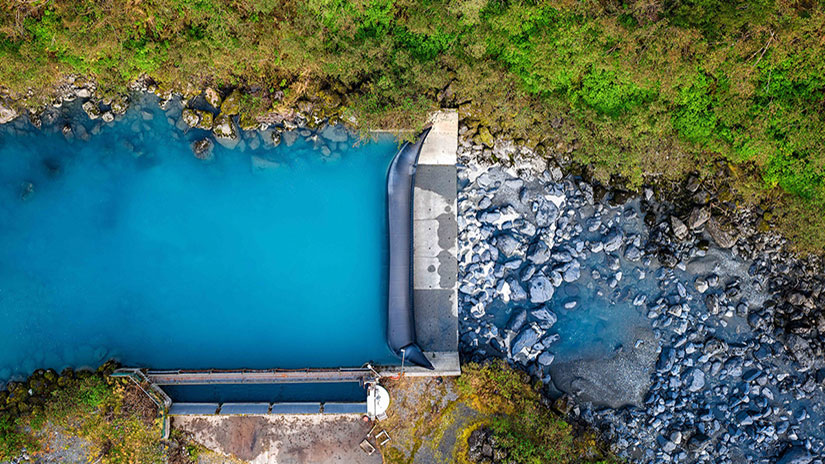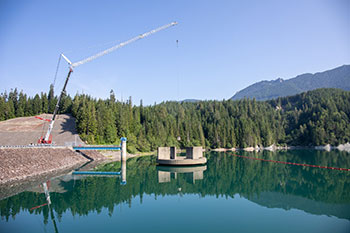New Report Shows It Is Time To Tap Into Hydropower Investment Opportunities
With the clean energy transition well underway, there is plenty of exciting news about increasing deployment of renewable energy solutions like solar. Yet as more of these variable renewables connect to the grid, there is an increasing need for firm, flexible, and renewable power and storage to balance supply and demand.
One potential solution is hydropower, which has long proven it can meet that need and provides 96% of the nation's utility-scale energy storage capacity. In fact, hydropower's longstanding reputation as a reliable source of energy and storage may ironically be one of the reasons people often assume it is "tapped out" of investment opportunities, but this is not the case.

The Power Creek Dam Project in Cordova, Alaska, includes a hydroelectric plant located 7 miles east of Cordova with a total installed generating capacity of 6 megawatts. Photo by Levi Rowland, edited by Deanna Kendall, and released by Thomas Tapp, Seed Media
Far from being tapped out, hydropower, including pumped storage hydropower (PSH), still has enormous potential for growth, particularly for small- and medium-sized projects (or those that produce up to 30 megawatts of power). In fact, less than 3% of the more than 90,000 dams in the United States produce power, with thousands of nonpowered dams offering excellent opportunities for investment. In addition, dams that do currently produce power can often be updated to increase capacity. There are also millions of miles of waterways, including both rivers and canals, that can be utilized for in-stream hydropower.

A valve is replaced at Morning Glory Spillway in Snohomish County, Washington. Photo from Krysta Rasmussen
A new report, Hydropower Investment and Public-Private Ecosystem Assessment, developed by the National Renewable Energy Laboratory (NREL), provides a comprehensive analysis of both the risks and opportunities for investing in small- to medium-sized hydropower and PSH projects. Key findings from the study, which was funded by the U.S. Department of Energy’s Water Power Technologies Office (WPTO), include:
- Medium-sized projects offer significant opportunities for low-impact hydropower development. The current medium-sized project pipeline includes projects that would constitute a total capacity of more than 1 gigawatt and involves capacity additions, nonpowered dam retrofits, hydropower generation in conduits, PSH, new stream-reach development, and hybrid projects that combine multiple renewable technologies.
- New technology innovations and the variety of sites on which hydropower could be developed
present potential opportunities for future investment. Top areas of interest include:
- Modular conduit hydropower: In the last decade, developers have begun designing and deploying small modular conduit systems, which can be manufactured off-site and then assembled on-site. This approach can decrease construction costs, reduce project timelines, and increase flexibility to expand the size of a hydropower system in the future. One example highlighted in the report of a company pursuing modular conduit hydropower is Emrgy, which raised several million dollars in private investment.
- Nonpowered dam resources: Because about 97% of U.S. dams do not have power-generating infrastructure, nonpowered dams represent an attractive development opportunity with a potential capacity of 2 gigawatts or more within the medium-sized range.
- Hybrid plant configuration: Utilizing hydropower in a hybrid configuration with other renewables and battery storage can unlock new revenue streams by providing power during peak demand or ancillary services such as the ability to adjust quickly to ensure grid reliability.
- Closed-loop PSH innovation: Closed-loop PSH systems feature two reservoirs that are not connected to a naturally flowing water feature like a river. These projects, which can offer siting flexibility, account for the majority of PSH projects in the pipeline. These projects would be the first closed-loop facilities in the United States.
- Investors surveyed for this study generally expressed the greatest level of interest in supporting capacity additions at existing facilities. With a connection to the grid already established, these existing facilities offer critical opportunities to increase clean energy production.
Read the full article, originally published by WPTO, to learn more about opportunities to increase investment in hydropower and PSH. You can also dive deeper into the new hydropower investment landscape report.
Learn more about NREL's hydropower research. And subscribe to the NREL water power newsletter, The Current, to make sure you do not miss a water power update.
Last Updated May 28, 2025
